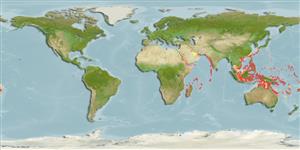Hexacorallia |
Scleractinia |
Faviidae
Environment: milieu / climate zone / गहराई सीमा / distribution range
पारिस्थितिकी
प्रवाल-भित्ति संयुक्त; गहराई सीमा 0 - 48 m (संदर्भ 107548). Tropical; 36°N - 35°S, 32°E - 137°W (संदर्भ 848)
Indo-West Pacific.
Length at first maturity / आकार / Weight / Age
परिपक्व अवधि: Lm ? range ? - ? cm
Colonies are large, with rounded projections. Meandroid valleys give this species its resemblance to a brain. Color is consistently light brown, with a clear surface.
Occurs in most reef habitats, particularly back reef margins. On subtidal rock and rocky reefs, back and foreslope, lagoons, and outer reef channel (Ref. 98471). Form large colonies with rounded projections. A few borers or nestlers can be found on its surface (Ref. 130769).
Life cycle and mating behavior
परिपक्व अवधि | पुनरुत्पत्ति | मछलीऔ का अंडे देना | Eggs | Fecundity | Larvae
Hermaphroditic (Ref. 113712). Mature gametes are shed into the coelenteron and spawned through the mouth. Life cycle: The zygote develops into a planktonic planula larva. Metamorphosis begins with early morphogenesis of tentacles, septa and pharynx before larval settlement on the aboral end (Ref. 833).
Babcock, R.C. 2003 Identification of Sclerectinian Coral Recruits from Indo-Pacific Reefs. Zoological Studies 42 (1):211-226. (संदर्भ 791)
IUCN Red List Status
(संदर्भ 130435: Version 2025-1)
CITES status (संदर्भ 108899)
CMS (संदर्भ 116361)
Not Evaluated
Threat to humans
Human uses
| FishSource |
साधन
अधिक जानकारी
Trophic EcologyFood items (preys)संघटक आहारआहार खपतपरभक्षी Population dynamicsबाढ़Max. ages / sizesLength-weight rel.Length-length rel.Length-frequenciesMass conversionबहुतायत PhysiologyOxygen consumption
Human RelatedStamps, coins, misc.
इंटरनेट स्रोत
Estimates based on models
Preferred temperature
(Ref.
115969): 24.8 - 28.9, mean 27.6 (based on 370 cells).
Price category
Unknown.
